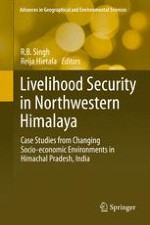2014 | OriginalPaper | Chapter
9. The Challenges of Reforesting the Himalayas Through the Clean Development Mechanism: Perspectives from Rural Villages
Author : Toni Haapanen
Published in: Livelihood Security in Northwestern Himalaya
Publisher: Springer Japan
Activate our intelligent search to find suitable subject content or patents.
Select sections of text to find matching patents with Artificial Intelligence. powered by
Select sections of text to find additional relevant content using AI-assisted search. powered by
